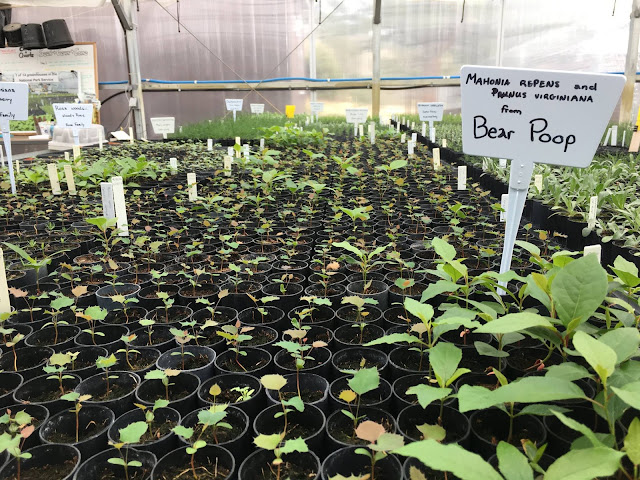We were ably led by National Park Service rangers/biologists Kate, Camille, and Jesse, and for four days we worked a variety of tasks. Many of us were surprised to learn that RMNP is one of just 14 national parks with state-of-the art greenhouses and plant nurseries and that the biologists did extensive work eliminating invasive plant species and re-planting areas where human interference had injured the park flora. And since the park has different species of plants on the east and west sides of the mountains, each area gets only the plants appropriate to its side. Also, since the high alpine areas like Long's Peak at 14,259 feet elevation (the highest point in RMNP) have yet a third type of flora, the rangers hike up there to harvest seeds from up high as well as to revegetate the alpine areas with flora grown from those seeds. The greenhouse produces between 35,000 and 55,000 plants annually for restoration work! Once, a small Ziplock bag full of bear scat collected by a ranger had enough small berry seeds to grow 1200 seedlings of Oregon grape and chokeberry.
The first day we went to Moraine Park Campground and removed invasive monk and bull thistle seed pods seen below as round purple, white, and brown balls...
...as well as invasive mullein weed, seen below being held by ranger Camille...
Covering 48 acres, our group carefully removed the seed pods from these three varieties to prevent more infestation, and then we dug out the offending plants. The seed pods were placed into paper bags as seen above and taken back to the nursery area, where the bag and contents will be incinerated by this monster machine...
The bags are placed in the burn box and the flames come from the holes seen along the top right edge of the burn box...
On day 2, we were driven over the mountain to the west slope's Timber Creek Campground. A new sewer pipe had been buried in the campground and such human "disturbances" of the natural terrain have to be remediated, so we raked a narrow swath totaling just over half an acre to loosen the soil.
Camille and Jesse then spread the native Bromine grass seed on the loose soil...
...and then we covered it all with mulch to keep birds and other critters from finding and eating the seeds.
In the photo below, you can see about half of the area we worked on. The winter snows will blanket the area, and after melting next spring, the moisture will allow the seed to grow and once again the disturbed area will have native grass and blend in with the natural look.
...and then they collected the seeds of the bottlebrush squirreltail, a wild rye, cool-season, quick establishing but short-lived perennial bunchgrass seen below. The seeds were taken to the greenhouse to grow more plants for future use.
Meanwhile, five of us worked on improving the "security" of the encircling fence, which meant adding fine mesh to prevent critters from being able to climb through or up and over the fence as they attempt to reach the enticing young plantings.
The fence is already buried 18 inches into the ground to keep moles out, but agile animals can climb the fence, so we extended the height of the tight mesh fencing...
...and then curled the top to impede climbing over the top.
On the fourth day, we all went to the greenhouse/nursery area. Two varieties of plants which had been started in small cone-shaped containers had outgrown them and needed to be replanted in larger containers. Below, I am holding the container and the young plant which I have removed prior to replanting it in the round container on the table.
We transplanted over 500 plants into the larger containers where they will spend the winter before being replanted where they are needed next year.
Here are some of larger containers we had filled. The plants are below ground level for protection and they will be blanketed with a deep cover of mulch all winter, and next year they will be dug out of the mulch and then transplanted into the ground where needed.
We finished the day with a tour of the greenhouse with its fans and heaters and air conditioners and retractable roof. Kate and Camille explained the operation of the greenhouse and how it is vital to their mission.
A Ziplock of bear poop once yielded 1200 seedlings of orange grass and chokeberry!
Each day, our ranger-leaders were congenial and patient with us neophytes, explaining what to do and why we were doing it, calmly answering all our questions, and proficiently demonstrating how to perform the tasks we had been assigned.
Camille
Jesse and Kate
And special thanks to our Sierra Club leader, Jim...
And here's our stalwart crew of Sierra Club members who traveled from all over the country to assist in this week's efforts!
47 photos are available for download from Shutterfly here
Here's a brief video of our week's project:
Here's a brief video of our week's project:


















4 comments:
Looks like something I'd be interested in. Do they feed you and what kind of lodging? Etc.,etc.?
I'd go just to be around Camille.
Oops- I see some details in the description at the beginning.
Dear Chuck,
Would it be possible to get the name of the bands and songs in your blog: 2019 Sierra Club Service Project at Rocky Mtn?
Thank you,
Maria
Maria -- The songs are "Swamp Stomp" by Silent Productions and "Happy Mandolins" by MediaRight, both of which are from the YouTube Audio Library.
Post a Comment